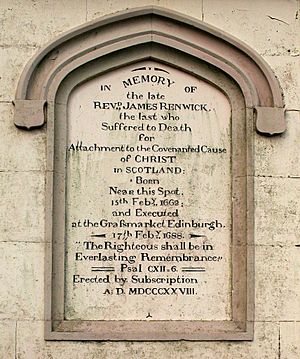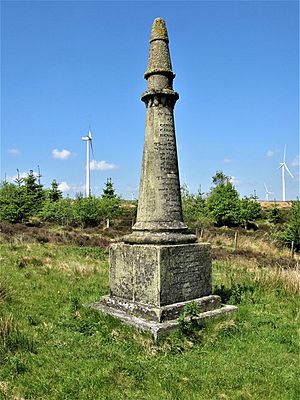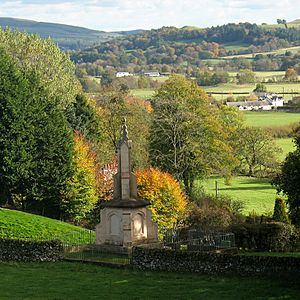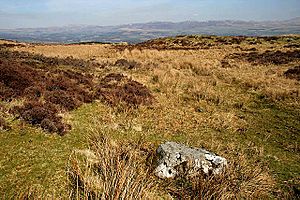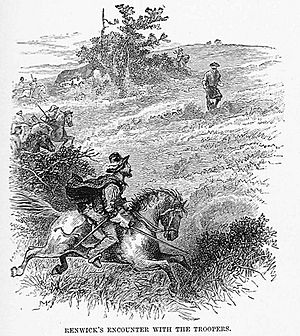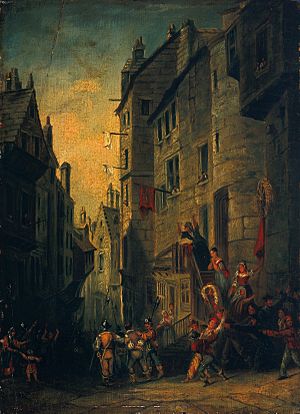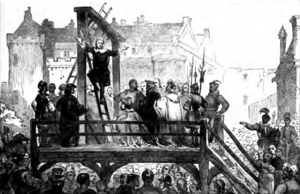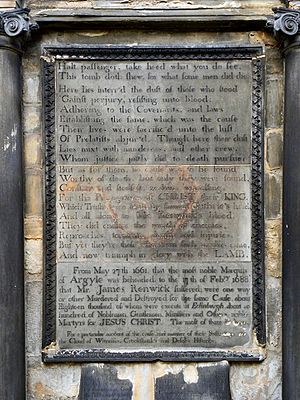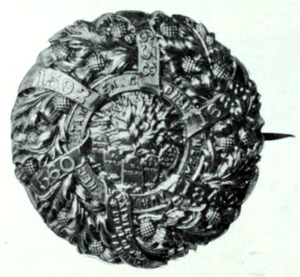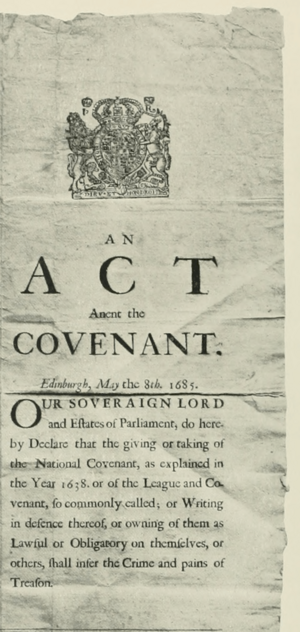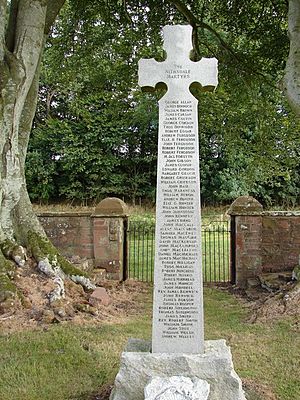James Renwick (Covenanter) facts for kids
Quick facts for kids
James Renwick
|
|
|---|---|
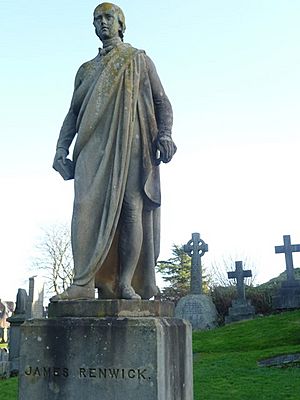
Statue of James Renwick, Valley Cemetery, Stirling by Alexander Handyside Ritchie
|
|
| Born |
James Renwick
15 February 1662 Moniaive, Dumfriesshire, Scotland
|
| Died | 17 February 1688 (aged 26) |
| Occupation | Minister, Covenanter, Martyr |
| Theological work | |
| Tradition or movement | Presbyterian |
James Renwick (born February 15, 1662 – died February 17, 1688) was a Scottish minister. He was only 26 years old when he was executed. His death marked the end of a harsh period of persecution in Scotland. This time was known as "The Killing Time." During this period, the Stewart kings tried to control religious freedom.
James Renwick was born in Moniaive, Dumfriesshire, Scotland. His father, Andrew Renwick, was a weaver. James studied at Edinburgh University. Around 1681, he joined a group of Covenanters called the Cameronians. He quickly became an important leader among them. Later, he studied to become a minister in the Netherlands. He was ordained in 1683.
When he returned to Scotland, Renwick became a "field-preacher." This meant he preached outdoors, which was against the law. The king's advisors declared him a rebel. In 1684, he helped write the "Apologetical Declaration." In this document, he and his followers said they did not recognize the authority of King Charles II. The king's advisors responded by ordering everyone to reject this declaration or face death.
In 1687, King James II allowed some freedom of worship for Presbyterians. But Renwick and his followers, sometimes called Renwickites, continued to hold their outdoor meetings. These meetings were still illegal. A reward was offered for his capture. In early 1688, he was caught in Edinburgh. He was found guilty of not recognizing the king's authority. James Renwick refused to ask for a pardon. He was hanged on February 17, 1688. He was the last Covenanter to be executed for his beliefs.
Contents
Who Was James Renwick?
Early Life and Family
James Renwick was born in 1662 in Moniaive. This village is in the Parish of Glencairn, Dumfriesshire. His father, Andrew Renwick, worked as a weaver. James's mother, Elizabeth Corson, had lost several children before James was born. They had all died as babies or very young children. People said that young James showed an interest in the church from a very early age.
Alexander Shields, who wrote about Renwick, said:
- "By the time he was two years of age, he was observed to be aiming at prayer, even in the cradle and about it..."*
Student Life in Edinburgh
In 1675, James's father, Andrew Renwick, passed away. James then went to the University of Edinburgh. There, he studied religion, especially the Presbyterian faith of his family. In 1681, he saw several Covenanters executed in Edinburgh. One of them was Donald Cargill. Witnessing these executions made him decide to join the Covenanters. These Covenanters followed the Sanquhar declaration of 1680. They were often called Cameronians, named after Richard Cameron.
In October 1681, James Renwick organized a secret meeting for this group. It was likely an outdoor church service. His strong passion helped rally them to continue their fight. They started sending letters between groups of supporters across western Scotland. On January 12, 1682, Renwick publicly announced the "Lanark declaration" in Lanark. Sir Alexander Gordon of Earlston helped arrange for Renwick to study theology in the Netherlands. This was so he could become a minister.
Becoming a Minister in the Netherlands
After Donald Cargill's execution, the United Societies of Covenanters had no minister. They could not find any minister in Scotland they trusted. So, they sent Renwick to Holland. He would receive training from Dutch professors. He would also be officially ordained by Dutch church leaders. From mid-1681 to late 1683, they had no preaching or sacraments. Renwick kept track of 500 baptisms he performed in his first year as a minister. He then "lost count."
Renwick studied at the University of Groningen and in Leeuwarden. Sir Robert Hamilton helped him get ordained. Renwick did not want to sign the Dutch church rules. He felt they did not agree with the Covenants. So, he was allowed to sign the Westminster Confession and catechism instead. His ordination certificate is dated April 9, 1683. A day later, a complaint arrived from Scottish ministers in Rotterdam. On May 10, he received letters of recommendation from the Groningen church group. He then went to Briel to sail back home. He left his first ship because some passengers were rude and tried to make him drink to the king's health. He switched to a ship going to Ireland. After some adventures, he reached Dublin. There, he found that the nonconformist ministers were not very interested in his cause. He then sailed to Scotland and immediately began his ministry.
Preaching in the Fields
When James Renwick returned to Scotland in 1683, he gave his first sermon. It was at Darmead, Cambusnethan, using passages from the Book of Isaiah. For the next five years, Renwick traveled around Scotland, preaching.
His first sermon was in September 1683 at Darmead Moss in Lanarkshire. He quickly became known as a field-preacher. The Scottish king's advisors declared him a rebel. Although he became famous, people misunderstood his position. Some accused him of strange beliefs. Sometimes, Renwick and his followers would secretly enter churches at night to hold their meetings. In 1684, efforts were made to capture him. In July, soldiers almost caught him, but he escaped. He lost his papers, though.
On September 24, orders were issued to prevent people from interacting with him. His followers then pushed for a new, defiant declaration. Renwick was hesitant at first. But in October, he wrote the "Apologetical Declaration." On November 8, 1684, this declaration was secretly posted on market crosses and church doors. It stated that they had the right to treat government agents as enemies of God. After two of the king's guards were killed during an attack on a field meeting, the king's advisors ordered the death penalty for anyone who refused to reject this declaration under oath. In April 1685, the Scottish parliament passed a law. It made any support of the Covenants an act of treason. This led to the second Sanquhar declaration, announced by Renwick and his followers on May 28, 1685.
Renwick refused to join the uprising in 1685 led by Archibald Campbell, the ninth Earl of Argyll. He agreed with the uprising's goal. But he did not join because it was not clearly based on the Covenants. This made many of his own supporters turn away from him. His old friend, Sir Alexander Gordon, who was in prison, turned against him. People saw him as someone who would only act on his own.
King James II's Scottish declarations of indulgence (February 12 and June 28, 1687) gave Presbyterians full freedom to worship. They could meet in meeting-houses or private homes. But they had to register and take an oath of loyalty. Outdoor meetings were still forbidden. These conditions were fine for most people. But Renwick and his followers would not accept any royal power to grant such permissions. They insisted on continuing their outdoor meetings. On October 5, a proclamation ordered harsh punishment for such meetings. On October 18, a reward of £100 was offered for Renwick, dead or alive. His friends must have been very loyal. He traveled around the country. He narrowly escaped arrest in Peebles. He reached Edinburgh. There, he gave a protest against the indulgence to Hugh Kennedy, a church leader. He later made sure it was widely known.
At the end of the year, he preached for several Sundays in Fifeshire. On January 29, 1688, he preached for the last time in Borrowstounness. Returning to Edinburgh, he stayed on the night of January 31 at a smuggler's house. A customs officer, John Justice, was watching the house. He heard Renwick praying with the family and suspected who it was. The next morning, February 1, Justice surprised him and tried to arrest him. Renwick defended himself with a pistol. He escaped to the Castlewynd in the Cowgate. There, he was caught and taken to the Tolbooth prison.
Trial and Execution
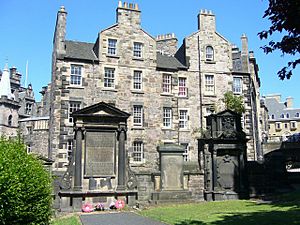
In 1688, James Renwick was finally captured. He was ordered to swear loyalty to King James VII and II. He replied:
- "No! I own all authority that has its prescriptions and limitations from the Word of God; but I cannot own this usurper as lawful king, seeing both by the Word of God such a one is incapable to bear rule, and also by the ancient laws of the kingdom which admit none to the Crown of Scotland until he swear to defend the Protestant Religion, which a man of his profession cannot do."*
Graham, the captain of the guard, was surprised by Renwick's small size and young appearance. He exclaimed, "What, is this the boy Renwick that the nation hath been so much troubled with?"
When the king's advisors questioned him, he hid nothing. His honesty and bravery made a good impression. He was charged with three things: not recognizing the king's authority, saying it was wrong to pay a certain tax, and saying it was right to use defensive weapons. Before his trial, his mother and friends were allowed to see him. On February 8, he was tried by the court and a jury of fifteen people. The trial was fair. Renwick admitted that all three charges were true. He was sentenced to be hanged in the Grassmarket on February 12. Later, his execution was delayed until February 17.
After his sentence, his friends could not visit him. But many clergy members, including Catholic, Episcopalian, and moderate Presbyterian ministers, visited him. John Paterson, the Archbishop of Glasgow, often visited him. He tried hard to get Renwick to ask for another delay, which would have saved his life. But Renwick was determined to die for his beliefs. It became a saying, "Begone, as Mr. Renwick said to the priests." On February 16, he wrote his final statement and a letter to his followers. Even on the morning of his execution, he was offered his life if he would sign a petition for pardon.
On the scaffold, he sang a psalm, read a Bible chapter, and prayed for a long time. He was executed on February 17, 1688. He had just turned 26 years old. He is remembered as the last of the Covenanter martyrs. James Guthrie was one of the first. Both are remembered on the "martyrs' monument" in Greyfriars' Kirkyard. This is where the original Covenant of 1638 was signed. The monument marks Renwick's burial place. It is on the wall near where criminals were buried.
After his execution, Renwick's head and hands were cut off. They were then put on the city gates. Before the year was over, the Stewart kings were in exile. The persecution of Covenanters ended. However, from 1689, Episcopalians faced persecution instead. The Covenanters saw Renwick's death as a sign of better times to come. His enemies said he followed "old Knox's principles" because of his strong determination. One person who loved him dearly wrote: "When I speak of him as a man, none more comely in features, none more prudent, none more heroic in spirit, yet none more meek, more humane and condescending. He learned the truth and counted the cost, and so sealed it with his blood."
An "Elegie" (a sad poem) about his death, written by Shields, was published in Edinburgh in 1688. A monument has been built to remember him near his birthplace. Renwick did not publish anything himself. But after his death, a collection of his "Prefaces, Lectures, and Sermons" was published. These were sermons he preached outdoors.
See also


